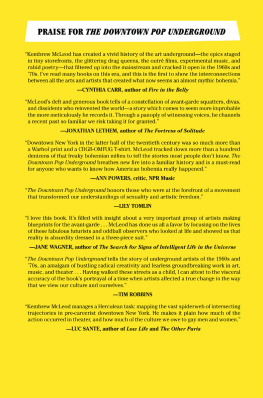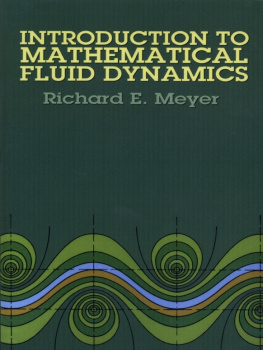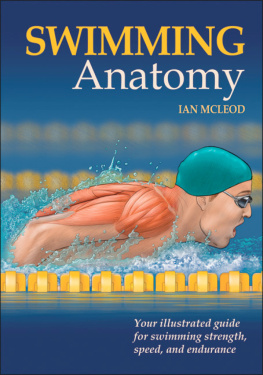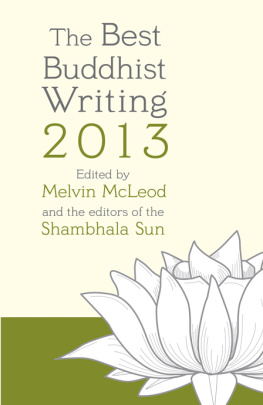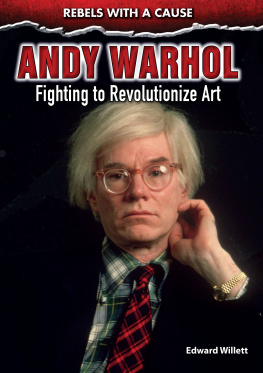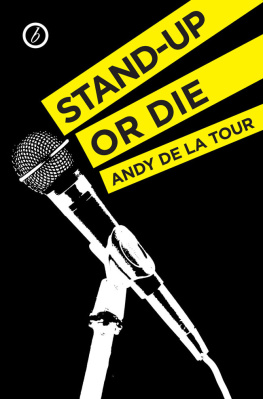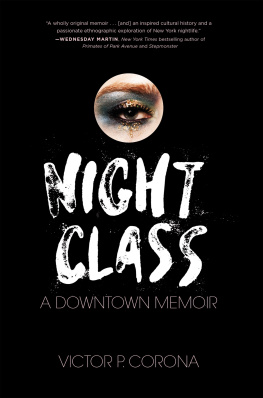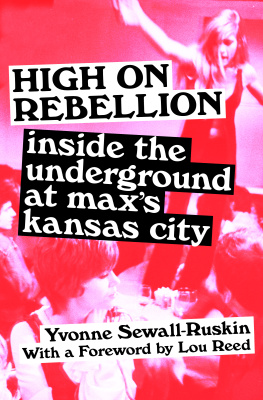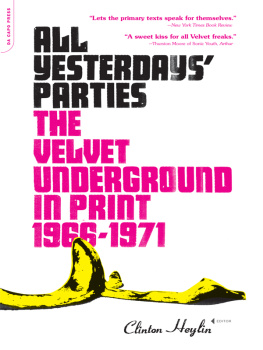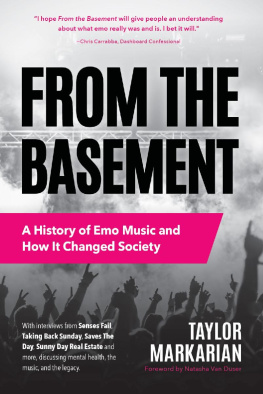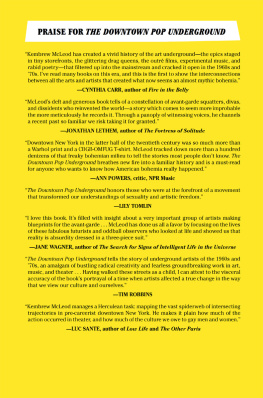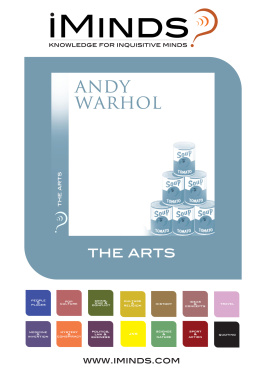
CONTENTS
Chapter 1
Harry Koutoukas Arrives in the Village
Chapter 2
Shirley Clarkes Downtown Connections
Chapter 3
Andy Warhol Goes Pop
Chapter 4
Debbie Harry, Patti Smith, and the Pop Generation
Chapter 5
Ed Sanders Incites an Indie Media Revolution
Chapter 6
Ellen Stewart Is La MaMa
Chapter 7
Hibiscus and Family Grow Underground Roots
Chapter 8
Preserving the Downtown Landscape for Artists
Chapter 9
Off-Off-Broadway Oddities
Chapter 10
Underground Films Bizarre Cast of Characters
Chapter 11
Multimedia Experiments at the Factory
Chapter 12
Chaos at the Cino
Chapter 13
Camping in Church and at Sea
Chapter 14
Migrating East
Chapter 15
Lower East Side Rock and Radicalism
Chapter 16
La MaMa Gets Ridiculous
Chapter 17
Jackie Curtis Takes Center Stage
Chapter 18
Madness at Maxs and the Factory
Chapter 19
Darkness Descends on the East Village
Chapter 20
From the Margins to the Mainstream and Back Again
Chapter 21
Femmes Fatales
Chapter 22
Underground Video Ushers In a New Media Age
Chapter 23
An American Family Bends Reality
Chapter 24
Pork, Glam, and Audiotape
Chapter 25
Literary Rockers
Chapter 26
Hibiscus Heads Home
Chapter 27
Mercers Mixes It Up
Chapter 28
DIY TV
Chapter 29
The Lights Dim on Off-Off-Broadway
Chapter 30
Punk Rocks Freaky Roots
Chapter 31
New York Rock Explodes
Chapter 32
Suburban Subversives
Chapter 33
Inventing Punk

MAPS DESIGNED BY AHNNA NANOSKI
List of Maps
Introduction
The 1960s and 1970s produced seismic shifts in American popular culture that can now be felt on a global scale. One major epicenter was downtown New York City, where the inhabitants of a roughly one-square-mile area of Lower Manhattan changed the way we think about music, art, performance, and human sexuality. These events were set in motion by a tight-knit creative community that made sparks fly as they brushed against each other. Expressing themselves without much thought about career development or sound business plans, they did it collectively in the spirit of fun and adventure.
The escapades of these experimental musicians, writers, activists, dancers, film- and video-makers, theatrical performers, and visual artists were set against a backdrop of social decay. New Yorks economy was decimated by a wave of white flight to the suburbs, starting in the 1950s, and its old industrial base also declined as manufacturers abandoned the citys crowded factory lofts and inadequate transportation systems, favoring the West Coasts tax breaks and better infrastructure.
The rise in poverty and crime was devastating for those who remained, but at the same time the downtown became a magnet for artists and other outsiders. Together, they escaped into music, art, film, theater, and other fantastical worldstheir creativity enabled by inexpensive rents that lifted the burden of securing steady employment. It was much, much cheaper, recalled underground filmmaker and Village Voice critic Jonas Mekas, a Lithuanian immigrant who came to America after World War II. Between 53 and 57, I lived downtown on 95 Orchard Street, he said, and I paid fourteen dollars and ninety-five cents a month, for one floor. That was how cheap it was. During the same period, the same space uptown would be maybe seventy-five dollars, which made a big difference.
Andy Warhols longtime residence on East Seventy-Fifth Street, in the tonier Upper East Side, stood in sharp contrast to the decrepit downtown environs where he socialized. Manhattans midtown, sandwiched between these two zones, was the nations center of cultural power in the decades after World War II. Along with the Broadway theater district, it hosted all three national radio and television broadcasting networks (CBS, NBC, and ABC), as well as major book, newspaper, and magazine publishers. They presented images of Eisenhower-era idealism and a conformist cultureskin-deep representations that would soon be punctured by this books protagonists.
The peak period of mass medias influence coincided with an explosion of localized independent media. This was enabled by several technological breakthroughs: audiocassette recorders, portable movie and video cameras, and public access cable television. The older medium of print also felt a jolt thanks to the mimeograph machine, a relatively cheap duplicator that was later supplanted by photocopiers and home printers. Mimeo made possible the instant publication of zines that writers distributed in the streets and at indie bookstores, underground cinemas, and do-it-yourself (DIY) performance spaces. Alternative newspapers such as the Village Voice and East Village Other also fostered community connections and encouraged new forms of expression to flourish, as did the free-form New York City radio station WBAI.
The fact that midtown and downtown were just a few subway stops away from each other sparked a dialogue. Unlike other avant-garde scenes that existed outside New York City, the downtown areas close proximity to the nations media capital helped circulate cutting-edge ideas and innovations. Underground culture and popular culture have traditionally been viewed as diametrically opposed to each other, but the boundaries dividing the two are often blurry. Rather than living in different universes, they developed a mutually constitutive relationship that was transformativea point underscored by this books title.
***
The Downtown Pop Underground examines the intersecting lives of those who played major roles in the downtown arts scenes, creating a whole that was far greater than the sum of its parts. By surveying the social networks they were a part of, we can get a clearer view of how these artists worked across mediums and collaborated with their neighbors.
As a key connector figure, Andy Warhol circulated not only through uptown art circles, but also within the underground film, poetry, theater, and music scenes. He is joined here by an ensemble cast of seven other main characters: H. M. Koutoukas, an outr playwright with a kaleidoscopic way with words; bohemian dancer Shirley Clarke, who evolved into a headstrong indie filmmaker and early video pioneer; Patti Smith, a punk-poet with roots in the underground theater movement known as Off-Off-Broadway; the trashy bleach-blonde Debbie Harry, who imploded the boundaries between pop and punk; Ed Sanders, a mimeo publisher, potty-mouthed poet, and frontman of the Fugs; DIY theater impresario Ellen Stewart, who cultivated an extended family of theater folks; and Hibiscus, the gender-fluid performer and founder of the psychedelic drag troupes the Cockettes and Angels of Light.
These interconnected individuals were nodes within a circuit that linked them to national and international mass-media outlets. Jacked into a system that amplified the downtown undergrounds subversive signals, their whispered messages could eventually be heard loud and clear. Of course, dozens of other downtown figures also broke new ground and had widespread influencefar more than could be catalogued in a ten-volume magnum opus, let alone this one book. A comprehensive history of this milieu is a fools errand, so I accepted some constraints.
While sorting through stacks of archival research and over a million transcribed words from my interviews, I gravitated to those individuals who straddled multiple mediums and art forms. This books primary themesexperimentation, hybridity, and border-crossingare embodied by Warhol, Koutoukas, Clarke, Smith, Harry, Sanders, Stewart, and Hibiscus. My focus on these eight people and their social networks limited
Next page
